A beautiful paver installation is more than just arranging stones in an attractive pattern—it requires careful attention to what goes between those pavers. Jointing sand plays a crucial but often overlooked role in the stability, longevity, and appearance of paver installations. This article explores why paver jointing sand is essential, the different types available including polymeric sand, proper installation techniques, and maintenance practices to keep your paver surface looking its best for years to come. Understanding these fundamentals can help homeowners make informed decisions about their hardscaping projects and avoid costly repairs down the line.
What Is Jointing Sand and Why It Matters
Jointing sand is the material that fills the spaces between individual pavers in a patio, walkway, or driveway installation. Far from being just filler, this sand serves several critical functions. First, it locks the pavers together, creating a unified surface that distributes weight and prevents individual pavers from shifting or rocking. Second, it helps prevent weed growth between pavers by occupying the space where seeds might otherwise germinate. Third, it deters insects, particularly ants, from establishing nests beneath your paver surface. Finally, properly maintained paver joints contribute significantly to the overall aesthetic appeal of your hardscape, giving it a clean, finished appearance.
Without adequate jointing sand, pavers can shift and become uneven, creating trip hazards and allowing water to penetrate beneath the surface. This water penetration can lead to erosion of the base materials and cause settling or heaving during freeze-thaw cycles. The best sand for pavers isn’t necessarily the least expensive option—it’s the one that provides long-term stability and requires minimal maintenance.
Types of Jointing Sand for Pavers
When selecting jointing sand for your paver project, you’ll encounter several options, each with distinct advantages. Traditional jointing sand is simply fine-grained masonry sand. While inexpensive and readily available, it requires regular maintenance as it can wash out during heavy rain or when cleaning with pressure washers.
Polymeric sand represents a significant advancement in paver joint technology. This specialized product consists of fine sand combined with polymers that activate when exposed to water. The polymeric sand benefits are numerous: once activated, it hardens to form a semi-rigid bond that remains flexible enough to accommodate minor paver movement while resisting erosion, inhibiting weed growth, and deterring insects. Although more expensive initially, polymeric sand typically proves cost-effective over time by reducing maintenance requirements.
For environmentally conscious homeowners, there are now eco-friendly jointing sand options that offer similar benefits to polymeric products without harsh chemicals. As AskHomey experts often recommend, considering the specific needs of your project and local climate conditions is essential when selecting the best jointing material for your paver installation.
Proper Installation of Jointing Sand
The effectiveness of jointing sand depends largely on proper installation. The process begins with ensuring that the paver surface is completely dry and clean. Any moisture present during application can prematurely activate polymeric sand or cause traditional sand to clump, resulting in uneven filling of the joints.
After sweeping the sand into the joints, it should be compacted using a plate compactor for larger areas or a rubber mallet for smaller sections. This compaction process helps the sand penetrate deeply into the joints, eliminating voids that could lead to future settling. The process of adding sand and compacting should be repeated until the joints are filled to within about 1/8 inch of the paver surface.
For polymeric sand installations, the final step involves lightly misting the surface with water according to the manufacturer’s instructions. This controlled moisture activates the binding polymers without washing the sand out of the joints. Proper curing time—typically 24 to 48 hours without rain or heavy moisture—is essential for achieving optimal polymeric sand benefits.
Maintaining Paver Joints for Longevity
Even the best paver installations require periodic maintenance to preserve their appearance and structural integrity. Maintaining paver joints should be part of your regular property upkeep routine. For traditional sand joints, replenishing the sand annually is typically necessary, as weather and cleaning will gradually deplete the material.
Polymeric sand joints require less frequent maintenance but still benefit from periodic inspection. Look for areas where the sand has eroded or cracked significantly, as these may need to be repaired by removing the old sand and applying fresh material. When cleaning paver surfaces, use gentle pressure washing techniques or non-acidic cleaners to avoid damaging the jointing material.
Seasonal changes can affect paver joints differently depending on your climate. In areas with freeze-thaw cycles, inspect joints in spring for damage that may have occurred during winter. In rainy regions, check joints after heavy downpours to ensure they haven’t washed out. Promptly addressing minor issues with paver jointing sand prevents them from developing into more serious problems that could compromise your entire paver installation.
For more tips and to connect with reliable home service professionals, follow AskHomey on Facebook and Instagram.



